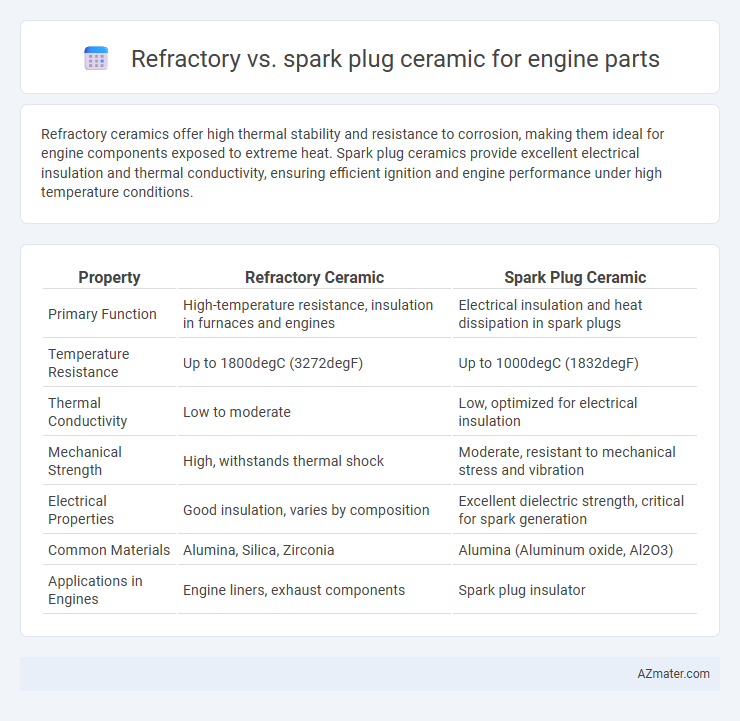Refractory ceramics offer high thermal stability and resistance to corrosion, making them ideal for engine components exposed to extreme heat. Spark plug ceramics provide excellent electrical insulation and thermal conductivity, ensuring efficient ignition and engine performance under high temperature conditions.
Table of Comparison
| Property | Refractory Ceramic | Spark Plug Ceramic |
|---|---|---|
| Primary Function | High-temperature resistance, insulation in furnaces and engines | Electrical insulation and heat dissipation in spark plugs |
| Temperature Resistance | Up to 1800degC (3272degF) | Up to 1000degC (1832degF) |
| Thermal Conductivity | Low to moderate | Low, optimized for electrical insulation |
| Mechanical Strength | High, withstands thermal shock | Moderate, resistant to mechanical stress and vibration |
| Electrical Properties | Good insulation, varies by composition | Excellent dielectric strength, critical for spark generation |
| Common Materials | Alumina, Silica, Zirconia | Alumina (Aluminum oxide, Al2O3) |
| Applications in Engines | Engine liners, exhaust components | Spark plug insulator |
Introduction to Engine Ceramics
Engine ceramics play a crucial role in enhancing thermal resistance and durability under extreme operating conditions. Refractory ceramics are designed to withstand high temperatures and corrosion, making them ideal for components like exhaust systems and combustion chambers. Spark plug ceramics, typically alumina-based, offer excellent dielectric properties and mechanical strength to ensure reliable ignition and insulation within the engine.
Understanding Refractory Ceramics
Refractory ceramics are engineered to withstand extreme heat and thermal shock, making them essential for high-temperature engine components such as exhaust valves and turbocharger parts. Unlike spark plug ceramics, which prioritize electrical insulation and thermal conductivity for efficient ignition, refractory ceramics emphasize durability and resistance to chemical corrosion in harsh combustion environments. Their unique microstructure and composition enable engines to maintain performance and longevity under intense operating conditions.
What Are Spark Plug Ceramics?
Spark plug ceramics are insulating materials designed to withstand extreme temperatures and electrical stresses within engine combustion chambers. Made primarily from alumina (aluminum oxide), these ceramics provide high dielectric strength and thermal conductivity, ensuring consistent spark generation and preventing electrical shorts. In contrast, refractory ceramics, while also heat resistant, are typically used for structural components requiring resistance to prolonged high temperatures and mechanical wear rather than electrical insulation.
Key Material Properties Compared
Refractory ceramics used in engine parts excel in high melting points, thermal stability, and resistance to wear and corrosion under extreme temperatures, making them critical for components exposed to intense heat and mechanical stress. Spark plug ceramics, typically alumina-based, prioritize high dielectric strength, thermal conductivity, and electrical insulation to ensure reliable spark generation and durability under rapid thermal cycling in combustion engines. The primary material differences lie in refractories' ability to withstand continuous thermal shock and chemical attack, whereas spark plug ceramics balance insulation with heat dissipation to maintain ignition performance.
Thermal Resistance: Refractory vs Spark Plug Ceramics
Refractory ceramics exhibit superior thermal resistance compared to spark plug ceramics, withstanding temperatures above 1,800degC without degradation. Spark plug ceramics, typically alumina-based, maintain excellent insulating properties up to around 1,400degC but may degrade under extreme thermal cycling. The high thermal stability of refractory ceramics makes them ideal for engine components exposed to intense heat, while spark plug ceramics balance thermal resistance with electrical insulation.
Electrical Insulation Capabilities
Refractory ceramics exhibit exceptional thermal resistance but generally have lower electrical insulation properties compared to spark plug ceramics, which are specifically engineered for high dielectric strength and electrical insulation in harsh engine environments. Spark plug ceramics, typically made from alumina (Al2O3), provide superior electrical insulation to prevent current leakage and ensure reliable ignition under extreme temperature and pressure conditions. Their optimized microstructure enhances mechanical strength and dielectric stability, critical for maintaining engine performance and efficiency.
Mechanical Strength and Durability
Refractory ceramics exhibit superior mechanical strength and high-temperature resistance, making them ideal for engine components subjected to extreme thermal and mechanical stress. Spark plug ceramics are engineered for electrical insulation and thermal shock resistance, but generally have lower mechanical strength compared to refractory materials. The durability of refractory ceramics in engines ensures longer service life and improved performance under continuous high-load conditions.
Application Suitability in Engine Parts
Refractory ceramics exhibit exceptional thermal stability and resistance to oxidation, making them ideal for engine parts exposed to extreme heat, such as combustion chambers and exhaust components. Spark plug ceramics, typically made from alumina, offer high dielectric strength and insulation properties necessary for reliable spark generation under high-pressure conditions. Selecting the appropriate ceramic material depends on the specific engine part's thermal, mechanical, and electrical demands to ensure optimal performance and longevity.
Cost and Manufacturing Differences
Refractory ceramics used in engine parts typically offer superior heat resistance but come with higher raw material and processing costs compared to spark plug ceramics, which are designed for optimal electrical insulation and thermal conductivity. Manufacturing refractory ceramics involves complex high-temperature sintering processes that increase production time and expenses, whereas spark plug ceramics utilize more standardized, cost-effective methods focused on precision molding and glazing. The choice affects both the initial component expense and long-term durability, with refractory ceramics favored in extreme thermal environments and spark plug ceramics preferred for electrical performance at a lower cost.
Choosing the Right Ceramic for Engine Performance
Refractory ceramics offer superior thermal resistance and durability, making them ideal for engine components exposed to extreme heat and mechanical stress. Spark plug ceramics, typically alumina-based, provide excellent electrical insulation and thermal conductivity essential for consistent ignition and engine efficiency. Selecting the right ceramic material depends on balancing thermal shock resistance, electrical properties, and mechanical strength to optimize engine performance and longevity.

Infographic: Refractory vs Spark plug ceramic for Engine part
 azmater.com
azmater.com